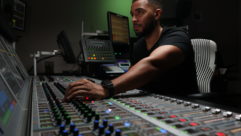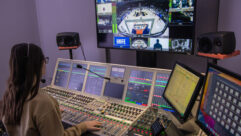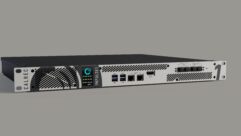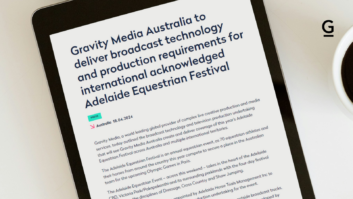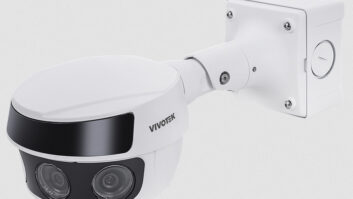As an accomplished A1 for almost 20 years now, Canada-based Patrick Castonguay loves the challenge of being creative with every live mix he produces. He’s worked on high-profile sports events including the Olympics (every year since 2002) and NHL and CFL games in Canada, as well as the JUNO Awards. The first Calrec console he ever used was the T Series, which was an analog/digital hybrid design.
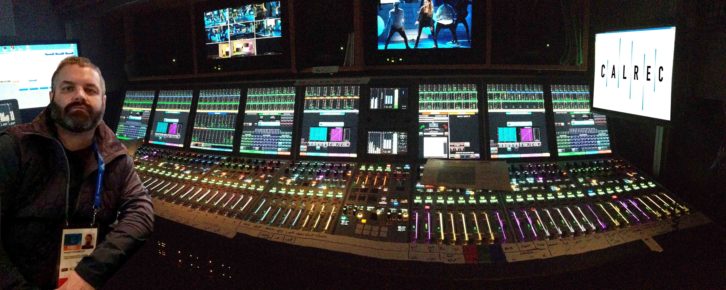
- We know you’ve been working as a freelancer for Dome Productions since 2001 and that your audio career began in a recording studio with your love of live music. In more detail, what does your current role entail?
I go between A1 (Audio Broadcast Mixer), Audio Guarantee and Comms Engineer. I have the fortunate pleasure of using those skills in every type of television production from live sports to news specials to entertainment. I work a lot of NHL and CFL games in Canada, which I really enjoy.
- What was it about audio broadcast that attracted you and what keeps you interested and challenged?
The fact that I’m never in the same place, same office with the same people every day makes it fresh for me. It includes the challenges of putting together a live television show. The evolving technology keeps my brain and curiosity always challenged. I get to be creative and I never get to do the same show twice!
- Can you talk us through the project you’ve most enjoyed working on and/or that really stands out in your career?
I’ve had the pleasure of working on every Olympics in different capacities since 2002. I remember mixing figure skating for OBS (Olympic Broadcast Services) at the 2010 Olympics in Vancouver and my Technical Manager asking me if I was nervous. I asked why. He told me that there was a potential viewing audience of over one billion people watching that night around the world; that blew my mind that so many people were listening to my work.
Another event that stands out is mixing The NHL 100 Classic in Ottawa in a football stadium where I was in charge of everything – audio and comms for the lead truck – and responsible for all the audio and comms feeds to four other broadcasters. All this was done battling -35Cweather. I feel very fortunate to have been exposed to all kinds of memorable events over the years. There are truly too many to count.
- Can you describe a typical broadcast audio setup that you use?
I mostly work NHL and CFL games in Canada, which for the most part are daily gigs so you’re in and out. I spend a lot of time setting up before a show and part of my workflow consists typically of knowing ahead of time the location of the venue, any mobiles I’m working with, the audio crew I have available to me and the production requirements that are needed on any particular day/show. Now I can base my prep not only on that show but the audio desk and intercom. So when I arrive on show day, my audio layout, integrated with intercom needs, is ready and notes are prepared for the A2s. It’s an attempt to keep the stress of the day low and keep things efficiently moving.
Most of the TV mobile trucks I use have a Calrec console: typically an Alpha or an Apollo, though there have been others. I have four sub-groups and five VCAs set up in the center. I like to keep all my mic sources on the left (FOP EFX, announcer mics, PA and Ref, etc)., and all my line sources on the right (EVS, Music, Spotbox, Duet, etc.)
- When did you first start working with Calrec products and what Calrec consoles have you used over the years?
I started working on Calrec consoles in 2002. The first one was the Calrec “T” series, which was an analog/digital hybrid design. I’ve worked on pretty much every model since then.
- What’s a recent example of a project where you used Calrec technology?
The last project I used a Calrec was the JUNO Awards, which is the Canadian version of The Grammy’s. I’ve been the Comms Engineer on that show for the last nine years. I use the Calrec Artemis console to bridge signals between the Hydra boxes on the floor and the MADI card in the RTS frame for all the wireless channels. I also use it to route many other comm sources to either a multitrack recorder or router points.
- What are the workflow advantages of the Calrec console(s) that you’re using?
I like to double and even triple assign sources to different destinations with different delays and or routing points. The Calrec makes it painless. Last year during the CFL season we started doing live mic games, which consist of having six players and two coaches mic’d and mixed in live during the broadcast. This becomes a challenge especially when the broadcast is in 4K. I have to provide eight discreet masters with different delays and the Artemis delivers that easily. Also, I’ve never run out of DSPs on a Calrec console — yet. That’s my own personal challenge, I admit!
- How do you view the current talk of, and move to, AoIP? What’s the real-world impact?
I’m curious, excited and cautious all at the same time. The technology is there and coming on fast but I see it as a new tool. Audio-over-IP is a really new technology that’s going to help me get the job done; it’s another one to add to the toolbox. It’s a good technology that I look forward to working with more in the future.
- The world of eSports has been on the increasing rise. How much does working in that world interest you and what experience do you have in that space?
I’ve worked on two different eSports events in the last two years. I mixed one and was a wireless comms tech on the other. It’s another exciting format in the new generation of pro sports.
- How have second screens (smartphones, laptops) changed how mixes are produced? What about viewer expectation for the perfect viewing experience; how as that impacted how you do your job?
I try to record every show I mix when possible. I then watch them at a later time with fresh ears and take notes to apply to subsequent mixes. I do this on different digital platforms like Facebook and You Tube, all on multiple devices.
I work with many mobile devices and the challenge is to overcome the vastly different listening environments. I make a point to try to get in touch with certain people I trust at home to verify my mix and I make the required adjustments on the fly. To be able to rely on experienced mentors is key.
- How do you see broadcast audio evolving in the next five years?
I see the REMI technologies bridging the gap between the home hub and the OB van as the bandwidth gets bigger and becomes more latency free. I don’t think that the OB van will be extinct but will be used more as an extension of the home hub and vice versa. These new technologies will help facilitate greater production demands either in the field or in the home hub. I see us exploring more with multiple immersive audio formats as we move forward.



